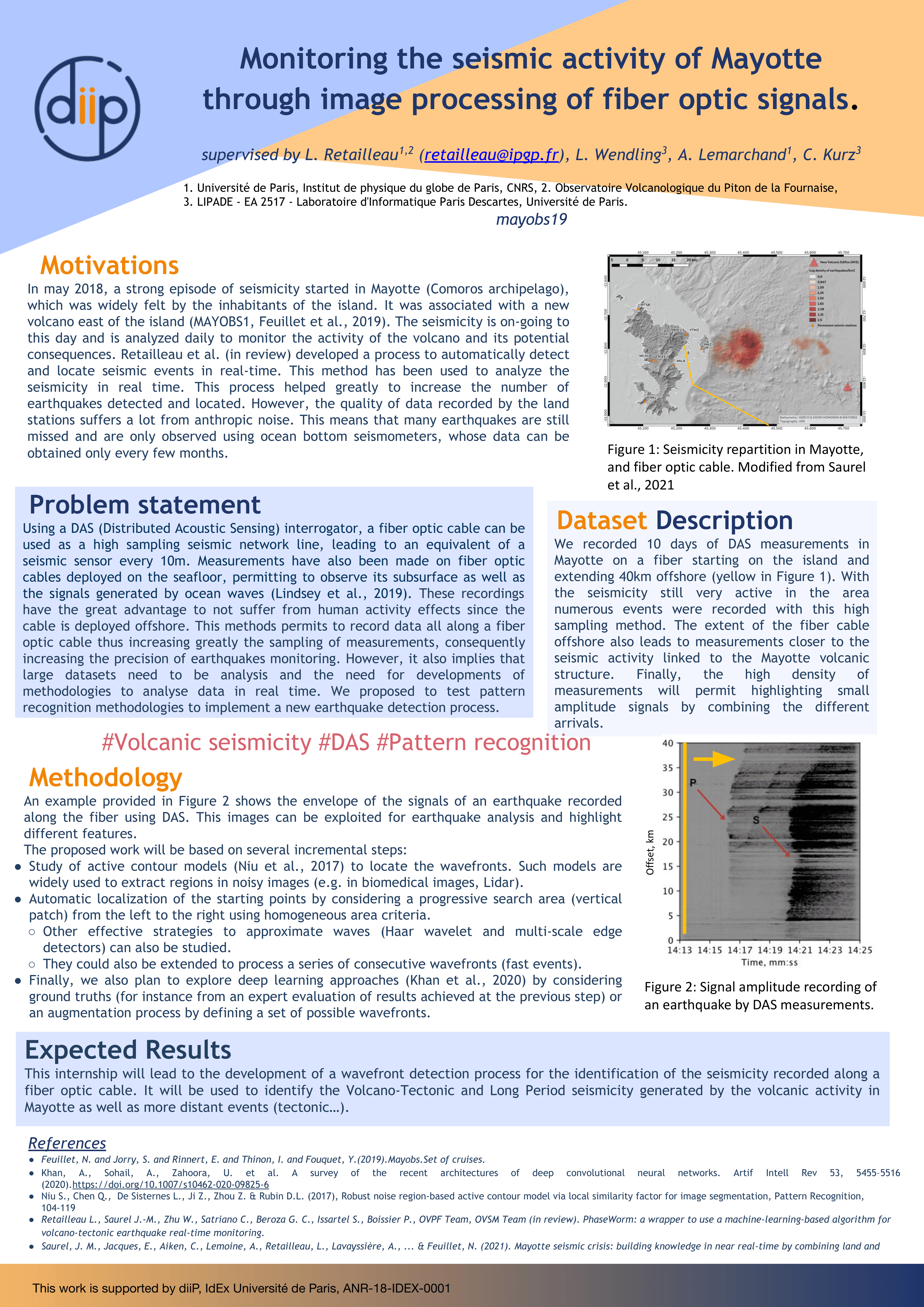2022
Masters Projects
@Computer Science
+Mathematics/Statistics
+Earth Sciences/Geosciences
#Earthquake
#fiber optics
#image analysis
#event detection
Project Summary
The seismicity in Mayotte is monitored daily using the seismic stations installed on the island. Retailleau et al. (under review) developed a process to automatically detect and locate seismic events in real-time. Using a neural-network-based method we identified the main waves (P and S) that are generated by an earthquake and then propagate through the earth and are recorded by the different seismic stations. The arrivals are then associated as an earthquake and are used to locate the event. This process helped greatly to increase the number of earthquakes detected and located. However, the quality of data recorded by the land stations suffers a lot from anthropic noise. In the last few years seismologists have increasingly used Distributed Acoustic Sensing (DAS) measurements. Using a DAS interrogator, a fiber optic cable can be used as a high sampling seismic network line, leading to an equivalent of a seismic sensor every 10m. Multiple studies showed that this data can be used in various contexts, to analyze seismic signals and to study the structure of the Earth (Zhan, 2020). On land, DAS recordings have been used to analyze Volcano-tectonic seismicity (Jousset et al., 2018) as well as anthropic signals (Lindsey et al., 2020). Measurements have also been made on fiber optic cables deployed on the seafloor, permitting to observe its subsurface as well as the signals generated by ocean waves (Lindsey et al., 2019). The proposed work will be based on several incremental steps: as a first step, we plan to consider active contour models (Niu et al., 2017) to locate the waves from a ground truth (approximate localization of P and S). Such models are widely used to extract regions in noisy images (e.g. in biomedical images, Lidar). They often required key points to initialize the fitting process near the region of interest (in this case the wavefront). We will choose these points from a polygonal approximation calculated on the given curves S and P. Secondly, we want to consider an automatic localization of the starting points by considering a progressive search area (vertical patch) from the left to the right using homogeneous area criteria. Due to the specificity of the wave – high density – we also propose to study two effective strategies to approximate waves (Haar wavelet and multi-scale edge detectors). The underlying idea is to provide a set of possible curves before running the active model process. Such methods could also be extended to process a series of consecutive wavefronts (fast events). Finally, we also plan to explore deep learning approaches (Khan et al., 2020) by considering ground truths (for instance from an expert evaluation of results achieved at the previous step) or an augmentation process by defining a set of possible wavefronts.
Lise Retailleau

Projects in the same discipline

Diffusion Models Based Visual Counterfactual Explanations
2024 Masters Projects @Computer Science #Visual counterfactual explanations #Diffusion Models #Identification of subtle phenotypesProject Summary to be updated Valerie MezgerProjects in the same discipline

OpenStreetMap and Sentinel-2 data for the production of environmental indices for demographic studies
2023Masters Projects@Computer Science +Demography #Remote sensing#Demography#Deep learning#Sentinel 2#OpenStreetMap#Local climate zones#Africa Project Summaryto be updated. Sylvain Lobry Projects in the same discipline

Diffusion Models Based Unpaired Image-to-Image Translation to Reveal Subtle Phenotypes
2023Masters Projects@Computer Science +Mathematics/Statistics+Biology+neurodevelopment #Image-to-image translation#Deep generative models#Diffusion models#Subtle Phenotypes#Neurodevelopment Project SummaryUnpaired image-to-image translation methods aim at learning a...

Generalization of a method enabling to update vineyard geographic databases from satellite data
2023Masters Projects@Computer Science +Earth Sciences/Geosciences #image time series analysis#deep learning#optical satellite imagery#agriculture monitoring#crop type mapping#vineyard#VENUS images Project Summaryto be updated. Camille Kurtz Projects in the same...
